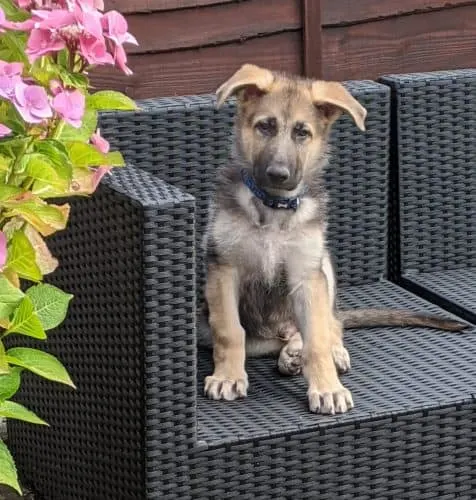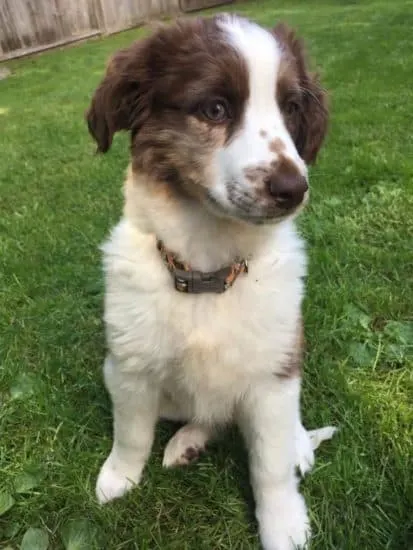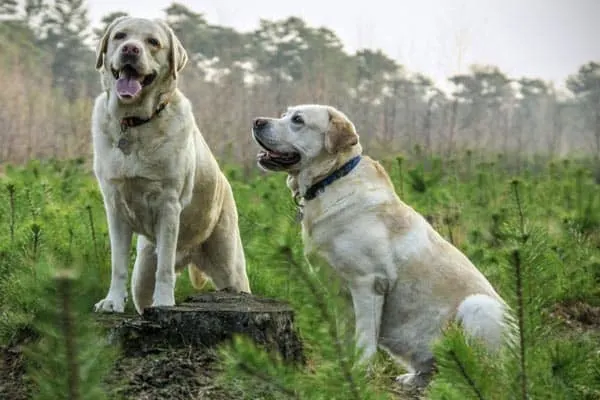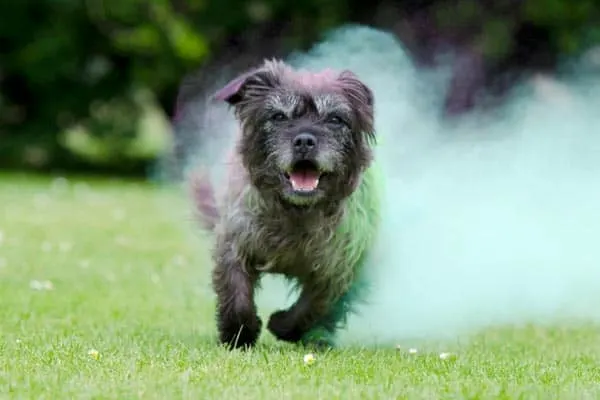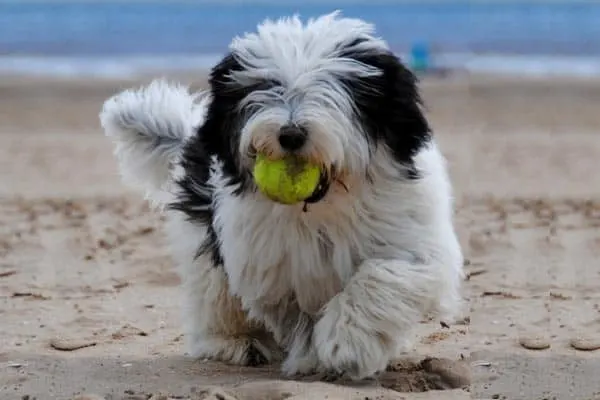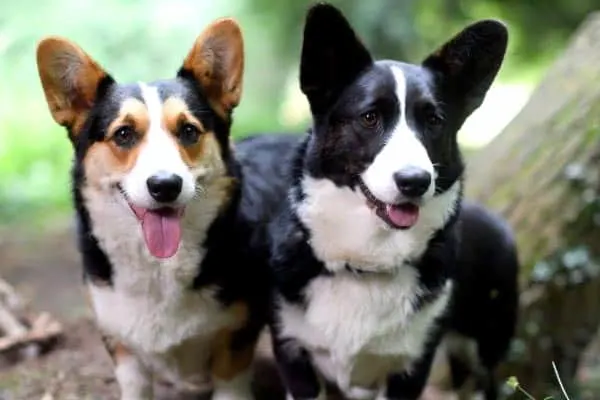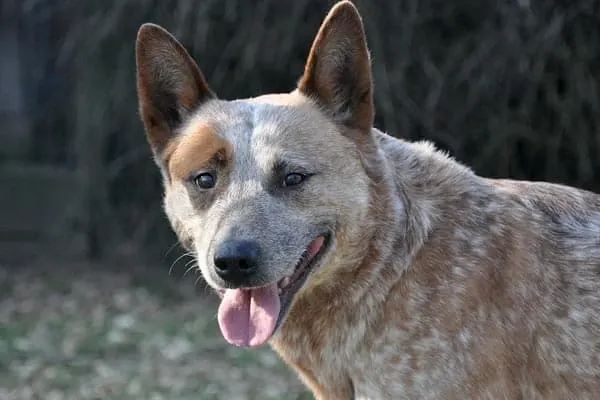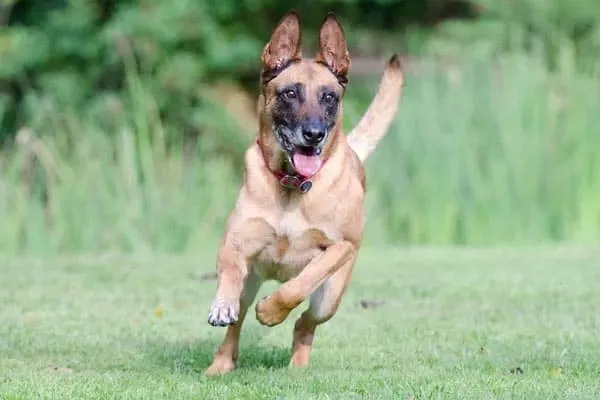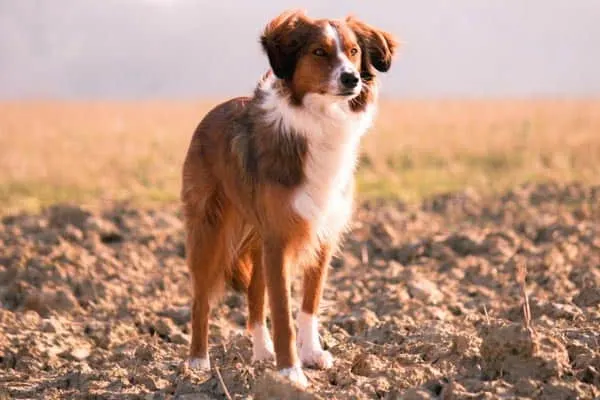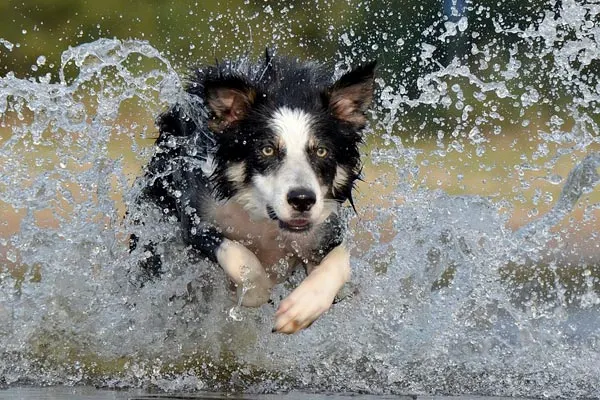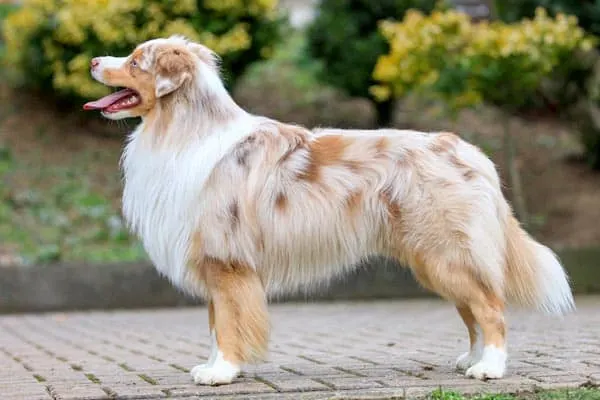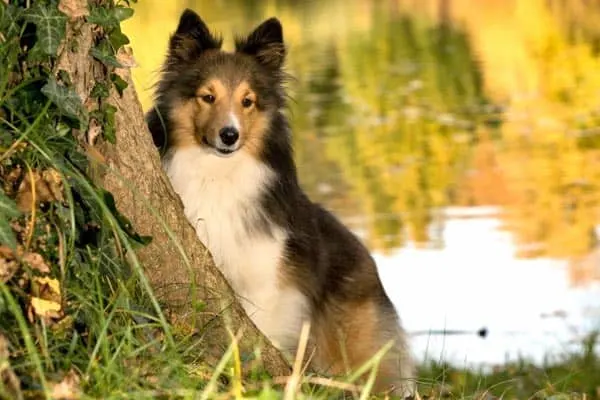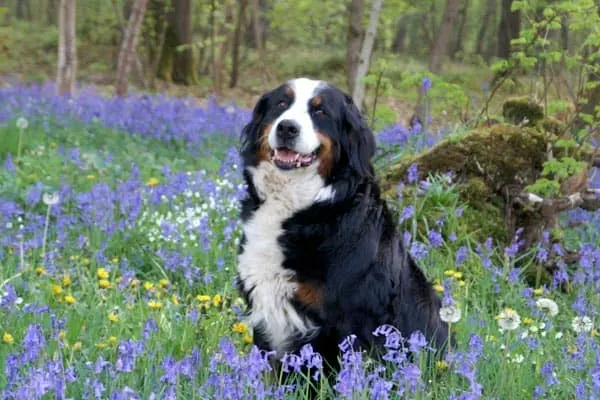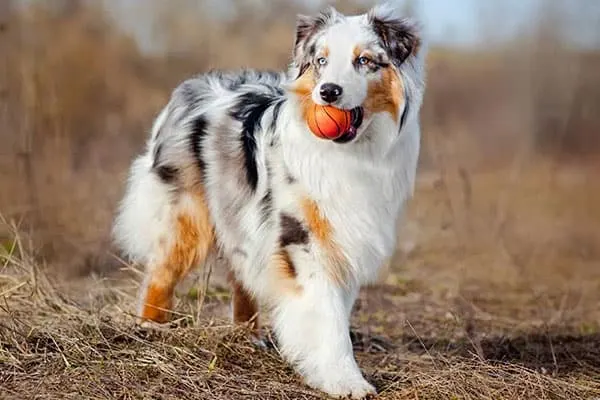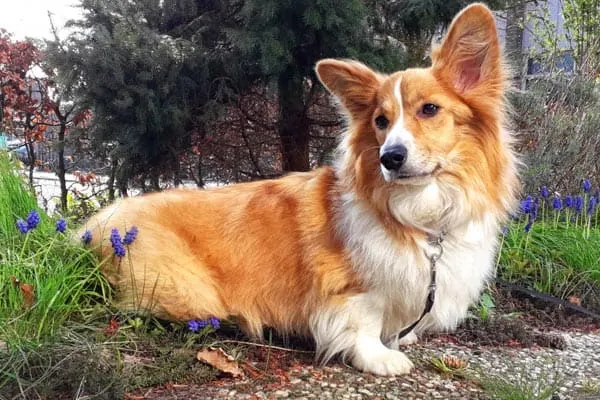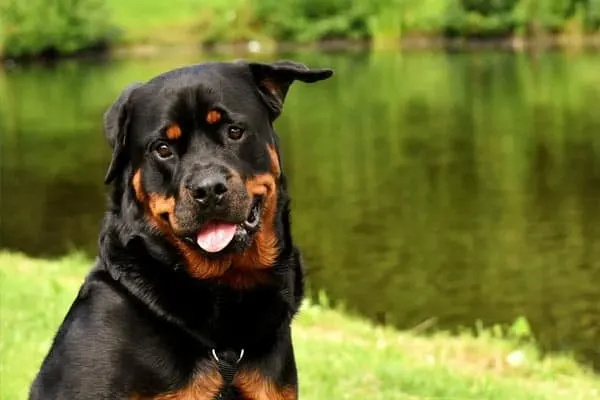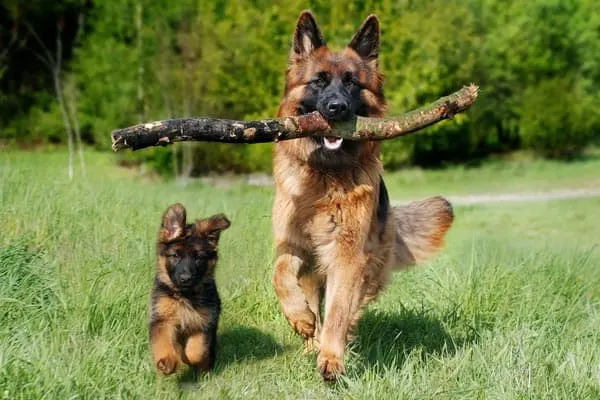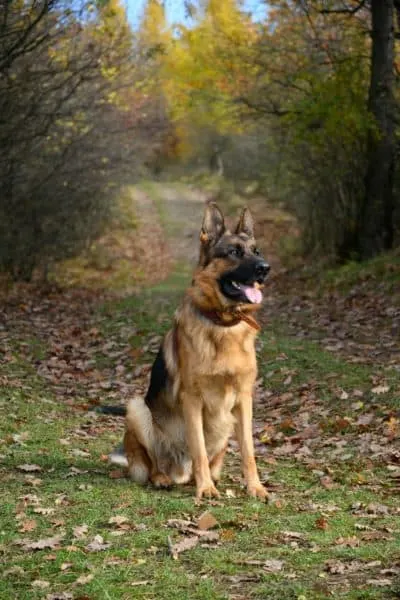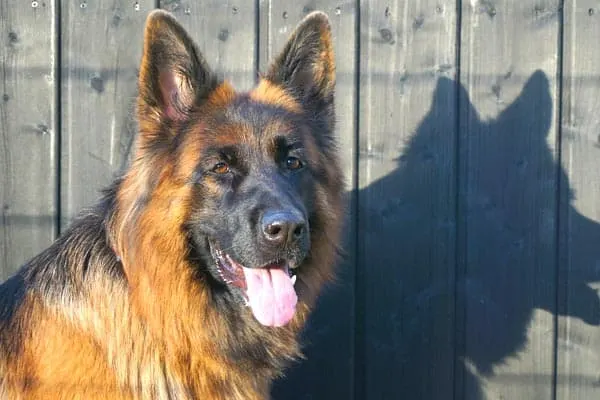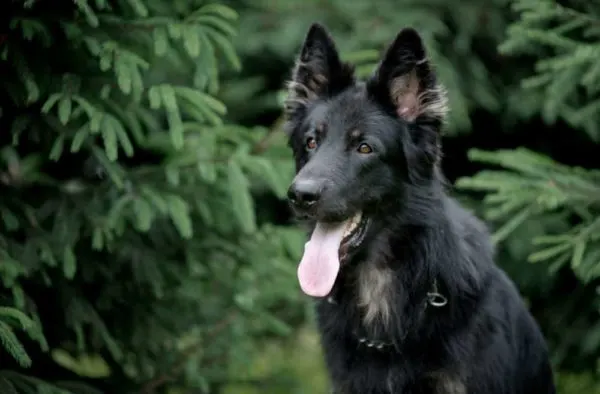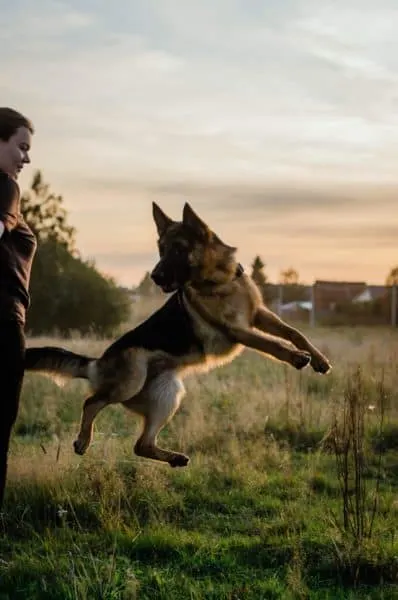How would you describe a shepherd dog if someone ever asked you? Would it be a classic German Shepherd or a similar breed? What about an Aussie or a Caucasian Shepherd?
The technical definition of a shepherd regarding dogs is any breed that humans have employed to help control livestock and move them from one place to another.
According to the strictest definitions, most dogs in that Herding Group are shepherd breeds. But how close is the relationship between what you typically think of as a shepherd, the GSD, and other herding breeds like the Border Collie?
And how would you classify dogs like the Rottweiler and Bernese Mountain Dog who moved livestock but did not make the cut into the Herding Class? Finally, where do LGDs, or livestock guardian dogs like the Kuvasz and Anatolian Shepherd factor?
We explore the herding dog background and different shepherd breeds that are popular in the USA and then delve into others that have great status in their native countries.
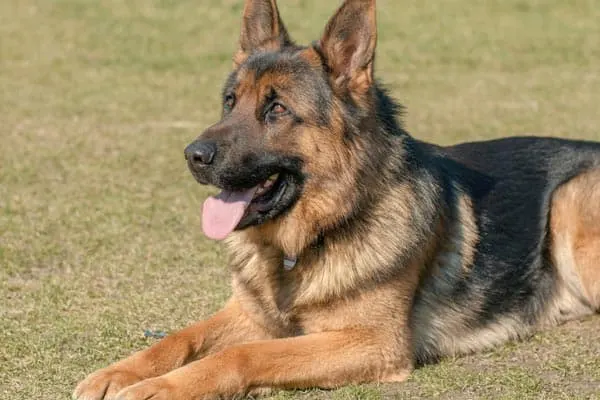
How did shepherd breeds evolve?
Organized herding is a relatively new concept. Although domestication of goats and sheep predecessors began as early as 9000 BC, the idea of enlisting dogs to at least protect livestock did not come about until about 1980 BC.
Livestock guardian dogs were a large part of the success of shepherds and their stock in their move from Asia to central Europe and onward. Likewise, domesticated dogs spread all over Europe.
Molossers developed around 600BC, according to Janedogs.com, and served multiple purposes.
They gave rise to Mastiffs and Mastiff-types, who were war dogs, hunters, guard dogs, and livestock guardians.
Around the 1570s AD, some Mastiff-type descendants became drover dogs, hauling produce and meats and helping move cattle and sheep to market.
Nomads and Peat dogs of about 2500 BC were the ancestors of some modern shepherds and herding dogs of central Europe.
Peat dog evolution occurred in the 1570s parallel to the Mastiff descendants’ timeline. They resulted in lighter and quicker dogs than the Mastiff-types and proved more useful for organizing livestock in particular areas of Europe like Italy, Germany, and France.
These new dogs could move small groups or individuals quickly and according to a shepherd’s bidding. They became known as shepherd’s dogs, and many registries designate these canines as true herding or shepherd breeds.
Who does the AKC say is a shepherd breed?
The American Kennel Club and most other registries have a classification system for all dogs they recognize. As of 2019, the AKC officially registers 193 breeds and seven classes of dogs. Of the almost 200 types, the AKC groups over 30 of them as herding dogs.
- Sporting
- Non-sporting
- Toy
- Terrier
- Herding
- Hound
- Working
The AKC also has a Miscellaneous Class, but all members go into one of the seven specialized classes once they receive full acceptance into the registry.
The Herding Group is a relatively new classification. The AKC once lumped the Herding and Working Groups together. Once the working dogs became too many, the AKC split the category in 1983.
While the AKC does not divide any of its classes, you can pick out certain categories of herding dogs and group them into types based on appearance.
- Shepherd – German Shepherd, Belgian Malinois, Belgian Sheepdog, Belgian Tervuren, Berger Picard
- Collie – Scotch Collie (Smooth and Rough-Coated), Border Collie, Australian Shepherd Labradoodle Mix: Meet the Smart, Sensitive Aussiedoodle Dog” target=”_blank” rel=”noopener”>Australian Shepherd, Shetland Sheepdog, Bearded Collie, Miniature American Shepherd, Pyrenean Shepherd
- Spitz – (Wedge-shaped heads, double coat, and curly tail) – Finnish Lapphund, Icelandic Sheepdog, Norwegian Buhund, Swedish Vallhund
- Sheepdogs – Old English Sheepdog, Polish Lowland Sheepdog
- Corgi – Pembroke Welsh and Cardigan Welsh
- Corded – Puli, Pumi, Spanish Water Dog, Bergamasco Sheepdog
- Cattle Dogs – Australian Cattle Dog, Entlebucher Mountain Dog
- Old World – Bouvier des Flandres, Briard, Canaan Dog, Beauceron
Some breeds, like the Dutch Shepherd and Australian Kelpie, are pending entries into the Herding Group.
As of 2020, the Dutch Shepherd has been a member of the Miscellaneous Class, the final step before full AKC acceptance. The Kelpie has been a member of the Foundation Stock Service since July of 2017.
How do genetics factor into shepherd classifications?
With the great strides in DNA sequencing and genetic analysis, scientists are learning more every day about where dogs originated and how geographic migration and selective breeding have changed relationships between groups. Genome mapping is particularly crucial in tracking hereditary health issues in specific breeds.
After extensive studies of thousands of canids, scientists grouped dog breeds into 23 clusters or clades.
The clades reflected high percentages of matching DNA between the dogs in the category.
Genetic tests group shepherds somewhat differently than our categories based on the AKC. The findings suggest multiple occasions where people cultivated the dog’s prey drive into herding instinct and continued development as dogs moved around the world.
For example, DNA studies show a common ancestor for the German Shepherd and five Italian Shepherds. Three Belgian Shepherds and the Briard, which historians often grouped in the same family as German Shepherds, are genetically in a separate cluster.
It would be interesting to see if the Dutch Shepherd formed a bridge between the GSD clade and Malinois cluster since outcrossing occurred between the DS and both the German and Belgian Shepherds well into the 1920s. Thus far, the data studies we compiled did not include Dutch Shepherds, seeming to focus on AKC-registered dogs.
New World Shepherds
Surprisingly, the German Shepherd shows close ties with the Peruvian and Mexican Hairless Dogs, suggesting quite a bit of outcrossing with the exotic dogs, perhaps to improve their hardiness.
- German Shepherd Dog
- Bergamasco Sheepdog
- Berger Picard
Continental Herders
Continental herders, like the New World Shepherds, are distinct from the “island shepherds” from the United Kingdom.
- Belgian Sheepdog
- Belgian Malinois
- Belgian Tervuren
- Briard
- Bouvier des Flandres
Mediterranean
Only separated by a branch from the German Shepherd, the Mediterranean genetic grouping includes two major types of ancient dogs. Sighthounds, such as the Afghan and Saluki, developed separately in the Mediterranean area from Greyhounds and Wolfhounds. The Mediterranean group also includes independent livestock guardians.
- Kuvasz
- Anatolian Shepherd (Kangal)
- Komondor
Rural UK (“Island Shepherds”)
The United Kingdom is rich in its creation of dog breeds. Genetically, sighthounds and collie-types may have had a common ancestor, most likely in a dog similar to the old Irish Wolfhound.
Not all of the collie-types had ancestry in the UK but remain genetically tied through extensive historical interbreeding. The UK rural genetic grouping includes, along with the herding dogs, the Whippet, Greyhound, Scottish Deerhound, and Borzoi.
- Australian Shepherd
- Scotch Collie
- Border Collie
- Old English Sheepdog
- Australian Cattle Dog
- Australian Kelpie
- Pembroke and Cardigan Welsh Corgis
Nordic Spitz
The Spitzes were some of the oldest breeds of dogs and had strong prey drives. Nordic Spitz dogs include the Keeshond and Norwegian Elkhound. Native people developed a few dogs in this cluster to herd their reindeer.
- Norwegian Buhund
- Finnish Lapphund
- Icelandic Sheepdog
Drover Dogs – In AKC Working Class
Most of the drover dogs no longer work with livestock in the US, but historically they drove cattle as the term suggests. Their large size makes them useful in several modern capacities such as guard and rescue operations.
- Rottweiler
- Greater Swiss Mountain Dog
- Bernese Mountain Dog
Miscellaneous
A few of the herding breeds, namely the Hungarian Puli, occupy a genetic class of their own.
With few exceptions, Shepherd breeds are the athletes of the dog world, often more so than gundogs. The herding class possesses significant speed with even the short-legged Corgi able to reach 23 miles per hour and the GSD and Border Collie 30 to 32 miles per hour.
Although not quite as fast as the sighthounds, herding dogs make up for it with boundless energy and tremendous stamina.
People continue to covet shepherd breeds because of their high intelligence, drive, and unique, attractive appearance. Moreover, herding dogs seem to transform when at work, mesmerizing with their agility and intensity.
Fifteen shepherd breeds made the top 100 most popular US dogs in 2019
The AKC has just released its top most popular dogs for 2020, and despite bad publicity, the GSD hangs steady at No. 2 behind the Labrador Retriever.
#94 Anatolian Shepherd
The AKC no longer distinguishes the Anatolian Shepherd from the Kangal. Having among the most robust jaws in the animal world, the Anatolian makes an unlikely friend with goats, sheep, and other livestock animals. The dogs fit within the dynamics of the herd, becoming accepted members.
Technically livestock guardian dogs and not herders, Anatolian Shepherds have helped conservation efforts across the globe, eliminating the need for people to kill cheetahs, wolves, and similarly endangered keystone predators. Posturing by the Kangals is usually sufficient to deter predation without harm to flocks, dogs, or wildlife.
Anatolian Shepherds are large light-colored dogs that originated in the Turkish area. They arrived in the US in the 1930s but did not make positive headway in the public eye until the 1970s.
#92 Bouvier des Flandres
The Bouvier is a large, rough-coated dog, 22 to 28 inches tall, and weighing 60 to 120 pounds. They are often grey or black but can also be fawn or brindle.
The Bouvier des Flandres originates in Belgium, where she mainly guarded and drove cattle. A recent era has seen the dogs’ use change to guard duty, police work, and family pets. Bouviers are even-tempered and learn readily.
Bouviers arrived in the United States in the 1920s, and the AKC accepted them in 1929. Belgian champions must be proficient working dogs.
#70 Old English Sheepdog
According to Ukcdogs.com, the Old English Sheepdog should be shaggy, neither curly nor flat-coated. Colors can be any shade of grey with white in a stereotypical pattern.
Dogs have a balanced bearing, typical of many shepherds, and have hips that are slightly higher than the shoulders. The Old English Sheepdog, still measured at the withers, can be 22 inches or taller.
Old English Sheepdogs should be smart and easygoing with a unique rolling gait. The OES dog has been around since the 1700s, probably attributing its heritage to a combination of English, mainland European, and Russian stock.
Despite their name, Old English Sheepdogs originally drove cattle, similarly to Rottweilers. The AKC accepted the Old English Sheepdog in 1888.
#66 Cardigan Welsh Corgi
A relatively old breed, the Cardigan Welsh Corgi has been in existence for about 3,000 years. The Cardigan has a Teckel ancestral line in common with the Dachshund. Although in Germany all Dachshunds were considered Teckels, the UK saw them as a specific family of wirehaired working dogs.
Historians believe the Celtics brought Corgis from Central Europe, according to The Cardigan Welsh Corgi Club of America.
Cardigan Welsh Corgis were heelers, specifically of cattle. In the mid-1920s, they underwent significant crossbreeding with the Pembroke Welsh Corgi until the official separation of the breeds in 1934. Cardis arrived in the United States in 1932.
Never as popular as the Pembroke, Cardigans just the same have a loyal and affectionate demeanor and are easy to train.
They make good guard dogs, and without proper socialization can be snappy. Unlike their Pembroke relatives, they have tails. Cardis is 10.5 to 12.5 inches tall and weigh 25 to 38 pounds.
#55 Australian Cattle Dog
No doubt you have heard of the Australian Blue Heeler or Red Heeler, but originally they were Halls Heelers.
They originated in New South Wales when Thomas Hall crossed local drover dogs with tamed Dingoes to produce a hardier dog that could handle the rough Australian terrain and unpredictable weather.
Just as their name suggests, Heelers herded cattle by nipping at their heels. They had to be exceptionally quick and agile to avoid flying hooves.
The Australian Cattle dog came to the US in the 1950s and gained entry into the AKC in 1980 as a working dog, just in time to transition to the herding group in 1983.
Heelers are active, intelligent medium-sized dogs with minimal grooming requirements. They are ticked red or blue often with tan markings and always have some kind of facial mask.
#41 Belgian Malinois
Originating from generic herding dogs near the Belgian-Dutch border, Belgian Shepherds received a different standard in 1892. The description effectively distinguished them from the GSD, although geographic separation probably limited interbreeding more than previously believed.
The Dutch Shepherd maintained close ties with Belgian Shepherds until 1914. Dutchie breeders revisited crossbreeding with all of the Belgian Shepherds after World War I to revitalize populations of short-haired, long-haired, and wirehaired varieties of the DS.
The Belgian Malinois is a unique breed in the United States, but in other areas, it is simply one of four variations of the Belgian Shepherd and remains the most popular of them. Belgian Malinois are becoming increasingly prevalent in the police and military in Europe and the US.
A Belgian Malinois resembles a German Shepherd but is slightly smaller. Malinois are most commonly fawn or red with black ticking, called agouti, and a flat head. A black mask is almost a universal feature of the Malinois.
The Malinois’ temperament is also slightly different, some people reporting him to be more command-driven and less self-preserving than the German Shepherd.
#38 Collie
Called the Scotch Collie, the Collie became popular in the 1800s in Scotland. Collies became a hit not only for their work with sheep in herding and guarding capacities, but they also were in high demand with royalty.
Collies arrived in the US to continue their tradition of herding sheep in the late 1800s.
Accepted by the AKC in 1885, the Collie’s popularity in America took off exponentially with the airing of Lassie in 1954. The series ran for 20 years. Rough-coated Collies, despite their considerable upkeep, remain more popular than the smooth-coated variety.
Collies are slightly smaller than German Shepherds, 22 to 26 inches tall and weighing 50 to 75 pounds. Scotch Collies are friendly, calm, and intelligent.
#33 Border Collie
Besides their reputation as the most intelligent dog breed, Border Collies seem to excel at anything athletic. Their medium and lean build enables them to motor effortlessly and speedily through agility and flyball, making turns that leave other breeds floundering.
Many herding trials are based on the Border Collie’s direct-gazed approach to controlling livestock, called a strong eye.
Border Collies can be a challenging breed for families. Although they are obedient and flashy, they tend to be extremely sensitive and have a strong herding instinct that sometimes translates into nipping at children and chasing cats.
#29 Miniature American Shepherd
It is unclear whether Miniatures American Shepherds have a particular affinity for horses or whether equestrians just love the portability of the dogs. Either way, the Mini has become a fixture on rodeo and equine show circuits. Moreover, an equestrian herself, Doris Cordova, is responsible for starting a formal breeding program in 1968.
Not involving any crossbreeding, the Miniature American Shepherd became smaller through selection for Australian Shepherds under 18 inches tall. Aussie breeders also had been selecting for oversized types to supply the demand for cattle dogs.
Minis have a strict height range from 13 to 18 inches tall. They weigh 20 to 35 pounds, vying with Corgis for the smallest herding dog status.
Miniature American Shepherds, originally Miniature Australian Shepherds, then North American Shepherds from 1993 until 1998, registered under their current name with the AKC in 2011. They received full recognition in 2015. The breed standard, except size, is similar to that for the Aussie.
#25 Shetland Sheepdog
Despite their striking resemblance to the Scotch Collie, Shelties are not miniature Collies per se. In fact, Collie fanciers forbade the little dogs from taking the name Shetland Collie.
Shelties probably originated amongst Nordic Spitz-type herding dogs, and breeders crossed them with British collie-types before they finally arrived in Scotland. Their final development took place in the Shetland Islands with infusions from the Rough-Coated Collie and later, King Charles Spaniel, Border Collie, and Pomeranian.
Shelties were strong little dogs who served as watchdogs, rounded sheep during seasonal events, and served as perimeter herders to keep sheep out of forbidden gardens. They remain loyal and affectionate and form strong attachments with their owners.
Shelties should be 13 to 16 inches tall, although the standards vary outside of the US. Shetland Sheepdogs came to the US in 1908, and the AKC accepted them in 1911.
Initially, there was a snafu that prevented the acceptance of most Shelties for registration because their pedigrees caused a mislabeling as Collie mixes. Today the breed thrives.
#23 Bernese Mountain Dog
Similar to their short-haired cousins, the Greater Swiss Mountain Dog, the Bernese is a large breed, 23 to 27.5 inches tall, and weighing 75 to 120 pounds. Originally, they were general-purpose farm dogs who hauled or carried goods to market and drove cattle. They were large enough to also serve as forceful protectors of property.
The 1850s saw the replacement of Bernies with smaller and more agile dogs, and the breed almost disappeared. Revitalization efforts took place beginning in 1892, and the first Bernese Mountain Dog made his way to the US in 1926.
Bernese Mountain Dogs make good pets as they are one Shepherd who is not extremely active. They can struggle with heat and hip dysplasia.
Bernese Mountain Dogs are attractive tri-color dogs with black, white, and tan in a stereotypical pattern. They are friendly and willing to please but require extensive socialization and training as some lines are prone to shyness.
#13 Australian Shepherd
Medium-sized dogs, Aussies are similar in ability and temperament as Border Collies. They are compact and balanced, not appearing as streamlined as a Border Collie. Their independent nature also probably prevents them from scoring as high as Border Collies in working intelligence. However, they are easy to work with and have a sense of humor that eludes many others in the class.
Australian Shepherds can be red or blue merle, red and white, or black and white. They can have eyes of striking shades anywhere from blue to hazel to amber with any mix of colors acceptable.
Australian Shepherds developed on the American frontier from Colorado to California in the 1960s, versatile at herding cattle and sheep. They can tolerate high altitudes.
#10 Pembroke Welsh Corgi
Historians, according to Mayflowercorgiclub.org, believe the Pembroke Welsh Corgis were originally Scandinavian in origin with Nordic Spitz breeds like the Swedish Vallhund in the early bloodlines. They came to Britain probably near 900 AD and were selected for great cattle herding prowess.
Flemish weavers may have added even more Spitz bloodlines when they settled in the 1100s in South Wales in Pembrokeshire.
Shortening the legs while retaining their strength gave the Corgis an advantage against cattle with their low centers of gravity. Cows often kick above the level of Corgis.
The Pembroke is the smallest of the herding groups and reached No. 10 on the most popular list of AKC dogs in 2019 for the first time. Both males and females are 10 to 12 inches tall and weigh 22 to 31 pounds. They make lively companions and vigilant watchdogs with a strong herding instinct.
Pembrokes are notably tailless, either naturally bred or docked shortly after birth in areas that allow it. Great Britain has banned tail docking and blames that for the breed’s sudden decline there. TV shows such as The Throne have revitalized Pembroke’s numbers overseas and they managed to come off of Great Britain’s Kennel Club Vulnerable Dogs List in 2018.
#8 Rottweiler
The AKC classifies the Rottweiler as a working dog and not a shepherd. However, one major early use of the Rottweiler, once known as the “butcher dog,” was to herd cattle to market, a practice known as droving. Herds moved at a fairly leisurely pace with human tenders and dogs motivating them.
Many Molossers, early mastiff-types, were drovers, and fanciers believe the Rottweiler descended from these during Roman times, similarly to the Bernese Mountain Dog.
Rottweilers arrived in Germany in 74 AD, presumably crossing the Alps with human shepherds from Italy.
In the streets of Rottweil, Germany, the Rottweiler also developed to haul meat in carts and was intensely protective of property.
Railways replaced much of the Rottie’s drover requirements, but she was a versatile dog who found work guarding personal possessions and patrolling on the police force. Police and military work saved the breed, which faced almost certain extinction in 1882.
Rottweilers arrived in the US with German immigrants in 1920 and joined the AKC in 1931. They have seen an explosion in popularity both to their benefit and detriment.
Attracting some of the same criminal owners as Pit Bulls do, Rotties have faced irresponsible breeding, neglect, and abuse, leading to aggressive behavior and expanding breed-specific legislation.
Rottweilers are large dogs, 22 to 27 inches tall, and weighing 75 to 130 pounds. Even well-socialized, their temperaments vary from sweet and amiable to wary of strangers and aggressive. They combine high intelligence and formidable power, which makes them a handful for most casual owners.
#2 German Shepherd Dog
Max von Stephanitz registered the first German Shepherd Dog, a Thuringian–type named Horand von Grafrath, in 1899.
Stephanitz proceeded to utilize a highly-disciplined approach to linebreeding and produced dogs that would end up proficient in police work, military duties, leading the blind, physical therapy, search and rescue, narcotics and bomb detection, countless canine sports, guard detail, and Schutzhund.
German Shepherds have a classic look that varies between working and show lines. They are among the most common dogs breeders turn to for improving their stock and creating novelty or designer breeds. Lately, German Shepherds are at the center of increasing controversy as commercialism, overbreeding, and irresponsible training destroys temperaments, conformation, and health.
German Shepherds are 22 to 26 inches tall and weigh 60 to 95 pounds. Typically black and tan or red and tan, dilute, and solid colors exist. The GSD originally was a generic perimeter herder of sheep, preventing their charges from straying into areas that would endanger themselves or crops. German Shepherds possessed a natural guarding instinct that the public quickly exploited.
The GSD remains highly popular because of his loyalty, focus, intelligence, obedience, and striking good looks. A strong dog mentally and physically, the GSD requires a confident owner.
What is different about the White Shepherd?
White Shepherds are German Shepherds who have a solid cream or white coat. They share an identical history and breed standard with the GSD other than coat color, which is a disqualification in Germany and the AKC as well as other registries.
White Shepherds typically have dark eyes and nose as well as heavily-pigmented lips and paw pads. White appears as a masking gene, according to Wgsdca.org, that is recessive to other colors. Thus, the coat color only appears in dogs who have two copies of the gene, although black and tan dogs are possible carriers.
The white coat color gene appeared as early as Greif von Sparwasser, Horand von Grafrath’s mother’s sire. Before there existed a breed standard for the GSD, human shepherds bred for the white color in their herding dogs so it would camouflage better with the sheep.
The United States and Canada imported several white dogs even as Germany banned them. Eventually, White Shepherds would become members of their own registry, the White German Shepherd Club of America in 1969.
The United Kennel Club accepted the White Shepherd as a separate breed in 1999, and the dog has memberships with the White Shepherd Association of Canada and the American White Shepherd Association of 1995.
Some have created GSD hybrids to improve the German Shepherd
Shiloh Shepherd
The Shiloh Shepherd is a German Shepherd Alaskan Malamute cross that had the goal of improving the GSD’s hips and other genetic problems. Motivated German Shepherd lovers began to selectively breed for better hips in the GSD in the 1970s.
Breeders added the Alaskan Malamute in 1989 for improvement in hip conformation and increased size; a particular White Canadian Shepherd in 2001 for size; and a Czech Wolf Dog in 2005 for size and genetic diversity.
The largest concern for the Shiloh Shepherd is a small gene pool. Shiloh Shepherds look like German Shepherds but are 26 to 30 inches tall and weigh 100 to 160 pounds.
King Shepherd
A second-generation F1 dog, King Shepherd originally crossed a purebred German Shepherd with a Shiloh Shepherd in the 1990s.
After the original hybrid’s creation by David Turkheimer and Shelly Watt-Cross, other breeds had influence, like the Great Pyrenese and additional Alaskan Malamutes.
King Shepherd is larger than the GSD with a squarer head. These shepherds can herd and are 26 to 30 inches tall and weigh up to 150 pounds.
Some obscure shepherd breeds are big in their home countries
Berger Picard
One of the closest living Shepherd breeds to German Shepherd; it also shared roots with the Beauceron and Briard but has undergone extensive genetic divergence from those two breeds according to recent gene mapping. Similarly to the GSD, they are now in a completely different genetic clade or cluster.
The Berger Picard is a French breed that has a common ancestor with the GSD and five Italian herding breeds (Bergamasco Shepherd, Pastore d’Oropa, the Pastore Della Lessinia e del Lagorai, the Lupino del Gigante and the Cane Paratore{last two are Border Collie-like Cane Toccatore variations}).
Canaan Dog
Ancient breed and national dog of Israel according to the AKC, used to herd and guard sheep; probably at least 4,000 years old.
Caucasian Shepherd
Massive dog about 25 to 27 inches tall and weighing 110 to over 200 pounds, he guards livestock in the Transcaucasia region that covers Georgia and parts of Russia.
Pyrenean Shepherd
The small dog used to herd sheep in the Pyrenees Mountains of France. They herded livestock as the Great Pyrenees guarded. Pyrenees Shepherds also served in World War I and provided foundation stock for the Australian Shepherd.
East-European Shepherd
East-European Shepherd (Vostochno Evropeiskaya Ovcharka) Looks like a large Russian variation of the German Shepherd, from whence it originated, but now it is a separate breed from crossing with native Russian dogs; particularly bred for size and frigid weather and as a guard dog, it is 26 to 28 inches tall and weighs 50 to 110 pounds.
Berger Blanc Suisse
Berger Blanc Suisse(White Swiss Shepherd) – In an unusual turn of events, Switzerland imported an American White German Shepherd in 1966. It developed a breed that the UKC recognized in 2017 and the FIC in 2002. While closely resembling the American and Canadian White Shepherd, the White Swiss Shepherd is of much different temperament, shyer, more docile, and almost clingy. They are excellent herding dogs but not proficient at guarding.
Basque Shepherd Dog
Basque Shepherd Dog – Landrace dog of Spain that probably gave rise to the Australian Shepherd when Basque and Australian shepherds brought them with them to the US. They are 19 to 25 inches tall and weigh 40 to 65 pounds. There are short- and long-haired types.
Dutch Shepherd
Dutch Shepherd – Breed fanciers rushed to save this breed from disappearance. The brindle counterpart from to the Belgian Malinois, the breed from the Netherlands differs in form and disposition from the similar GSD and Malinois. Its rise in numbers worldwide has been slow but steady.
Bohemian Shepherd
Bohemian Shepherd (Chodsky Pes) – The Czech government approved the public for breeding a dog they saw fit to patrol the border between Bohemia and Bavaria. The Bohemian looks much like a long-haired GSD with rich black colors and tan markings in a stereotypical pattern similar to a Doberman.
Conclusion
While impossible to mention all the shepherd breeds, we touched on most of the popular species in the US and others worldwide.
One of the fascinating aspects of a shepherd dog is how the parallel needs of multiple populations around the world inspired herding development in a wide variety of canine types.
Origins of shepherd breeds range from dogs resembling small huskies to wolf-like canids, bear-like Mastiff-types, Poodle-like dual-purpose water dogs, bizarre companions with dreads, and dachshund-like elves. They range from under a foot tall and 25 pounds to massive lazy behemoths over 30 inches and weighing 225 pounds.
Examples
While cattle often move slowly over miles, drover dogs work very hard. This Rottweiler must keep the herd moving together in the correct direction.
When traveling across pastures, herds may graze in a more relaxed and spread-out fashion. Physical correction comes as a nip at the heels or the dog’s charging into the herd’s space, but you can see livestock is mostly impressed by swift movements.
You can see how effective the Corgi is with herding cattle. This is a juvenile dog with young cattle. You saw the quick kick that missed the dog a little high.
Kelpies utilize a move called backing where they run on top of sheep. The backing is useful for tight quarters so the dog can get from one side of the herd to the other.
Everyone has to start somewhere. As green as this puppy is, however, she still has good herding instincts. You will note in this video and the next how the handler allows the dog to learn how her different actions move the sheep.
For whoever thinks sheep are not smart, watch how this herd has learned that staying up next to the handler is a zone of safety.
The Berger Picard has a similar learning curve and herding style as the closely related GSD.
If you look at the AKC classification Herding Group, the class encompasses a large number of dog breeds
- German Shepherd Dog
- Canaan Dog
- Belgian Sheepdog
- Belgian Laekenois – Wirehaired variety, not yet a separate breed per the AKC
- Belgian Tervuren
- Belgian Malinois
- Pembroke Welsh Corgi
- Cardigan Welsh Corgi
- Australian Shepherd
- Swedish Vallhund
- Spanish Water Dog
- Polish Lowland Sheepdog
- Pumi
- Australian Kelpie – Not yet fully recognized by the AKC; FSS
- Entlebucher Mountain Dog
- Norwegian Buhund
- Border Collie
- Shetland Sheepdog
- Dutch Shepherd – Miscellaneous Class; Herding Class pending
- Miniature American Shepherd
- Collie
- Finnish Lapphund
- Berger Picard
- Bergamasco Sheepdog
- Bouvier des Flandres
- Briard
- Puli
- Icelandic Sheepdog
- Old English Sheepdog
- Bearded Collie
- Pyrenean Shepherd
- Australian Cattle Dog
- Dutch Shepherd – Not yet fully recognized by AKC; Miscellaneous Class, Herding Class pending
























